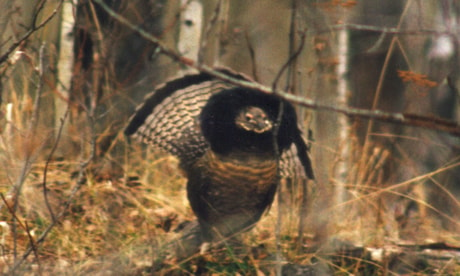My presence was required elsewhere, so I was marked absent on Provincial Hunting Day, Sept. 25th.
Usually Beau, my Brittany, and I head south and east for PHD to my old stomping grounds near Brooks, to inventory the standing pheasant crop for the coming season, and maybe even miss a shot or three at those pesky Hungarian partridges.
Nearer home, since the Sept. 15th opening of the season, oft have been heard discouraging words about the scarcity of ruffed grouse.
One reader who lives in good grouse country out west sends this enigmatic email: “As of late I have not made it out much for ruffies as there has been a moratorium placed on the grouse found on the walking trails of home, and I have not ventured too far from the house.” One constant contrarian, grouse-wise, sends a picture of the result of what obviously was a good hunting day in our Central Alberta grouse country.
Some time hunting and fishing buddy Neil Waugh, outdoors columnist for The Edmonton Sun, is having a tough time training his new Labrador pup, Penny, in grouse coverts near Edmonton because of the scarcity of the one indispensable ingredient to train a young bird dog . . . birds, birds, and more birds.
But Neil and Penny finally did have a good day recently: two ruffs in the bag from nine flushes. Then, the next day in the same coverts, they failed to find the scent of, or flush even one grouse.
As usual the debate rages over whether we are at the bust, the low of the notorious 10-year grouse cycle, or whether current low grouse numbers are merely the result of nesting failures, chick mortality caused by the last two cold, wet springs.
Kelly Semple, executive director for Hunting for Tomorrow, put out a timely release reminding recipients of the coming of the 4th annual Provincial Hunting Day and outlining the day-long event Hunting for Tomorrow and the Alberta Hunter Education Instructors’ Association were holding at the Alford Lake Conservation Centre for Excellence to introduce people to various outdoors activities and to improve skills.
The HFT release included some figures, such as that Alberta has recorded 112,804 hunters in 2009, a 12 per cent increase from 2005, consistent with stable or small increases in Alberta hunter numbers since 1996. Particularly pleasing to me is that the fastest growing segments of hunters are youth and female; for 2009 there were 6,865 recorded youth hunters and 7,755 female hunters.
Much of the credit for the increases is owing to Hunting for Tomorrow for its excellent pamphlets and courses to guide beginners through the jungles, the red tape tangles of legal gun ownership and the requirements for first-time hunters.
Some readers are ignoring hunting and are happily into fishing now that spring, summer and fall have suddenly arrived simultaneously. Apropos the recent Mitchell Lake column, a couple of readers report that too many anglers are killing too many fish there and that a slot limit should be imposed like at Beaver Lake, southwest of Caroline.
Coincidentally, another reader reports fantastic fishing during big backswimmer flights at Beaver Lake, and adds that Beaver’s red-fleshed rainbows are top table fare.
The great public land scam, or “chipoff,” whereby the government is considering selling 100 quarter sections of prime native public grassland near Bow Island to be plowed up for growing potatoes is continuing to draw flak from conservationists and public land advocates.
The recent column on the subject has drawn considerable reader comment, all outraged and opposed, some containing new information and allegations.
All commentators decry the secrecy the government employs to dispose of priceless public assets and a few allege this proposed sale is to a “politically connected potato grower.
A reader from deepest south potato country notes that these putative potato chips will require a lot of our limited water supply to grow and adds that “potato growing uses more chemicals than any other form of Alberta agriculture . . . the last of many sprayings is to kill the growing tops prior to harvest.”
Now Beau and I, along with our long-time hunting and fishing companion, Mac Johnston, are off south and east for parts of the three opening days of pheasant season.
We’ll not be hunting the scorched earth of any potato fields, but will confine ourselves to trying to find wild pheasants on native prairie grasslands, much of it on the superb 600,000 acres of Eastern Irrigation District grazing lands and some on the land of rancher friends.
From there come more discouraging words of sparse pheasant populations. Ranchers in my favourite areas blame the last two bitter winters down there and two very wet and cold springs in a row, particularly just at the time when eggs are hatching and chicks are coming off the nests. No matter; after more than 60 pheasant seasons I just like to be out and stomping, as best as I am able, in my old home grounds.
Bob Scammell is an award-winning outdoors writer living in Red Deer.
